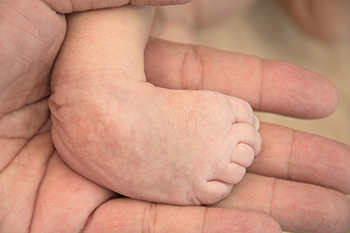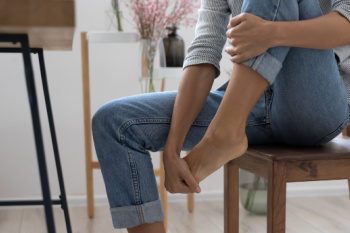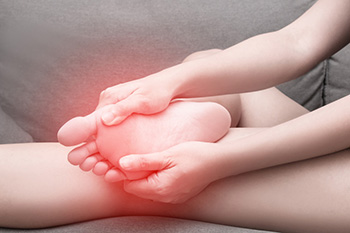Connect With Us
Blog
Items filtered by date: February 2025
Clubfoot Occurs When Feet Take a Different Path

Clubfoot is a condition where a baby’s foot twists inward at birth, making it difficult to place flat on the ground. Although the cause is not fully understood, it develops in the womb as tendons and muscles pull the foot into an unusual position. Walking can be challenging without treatment, but early care can guide the foot into proper alignment. Rather than being a limitation, clubfoot is a challenge that modern medicine can overcome. With stretching, casting, and sometimes minor surgery, most children grow up with strong, functional feet. The Ponseti method, a gentle, step-by-step process, is highly effective in reshaping the foot. While clubfoot may look concerning at first, it does not define a person’s mobility for life. Children can run, jump, and play with the right care. If your child is born with clubfoot, it is suggested that you see a podiatrist as quickly as possible for expert guidance.
Congenital foot problems require immediate attention to avoid future complications. If you have any concerns, contact Tanisha Richmond, DPM of Richmond Foot & Ankle, LLC. Our doctor can provide the care you need to keep you pain-free and on your feet.
Congenital foot problems are deformities affecting the feet, toes, and/or ankles that children are born with. Some of these conditions have a genetic cause while others just happen. Some specific foot ailments that children may be born with include clubfeet, polydactyly/macrodactyly, and cleft foot. There are several other foot anomalies that can occur congenitally. What all of these conditions have in common is that a child may experience difficulty walking or performing everyday activities, as well as trouble finding footwear that fits their foot deformity. Some of these conditions are more serious than others. Consulting with a podiatrist as early as possible will help in properly diagnosing a child’s foot condition while getting the necessary treatment underway.
What are Causes of Congenital Foot Problem?
A congenital foot problem is one that happens to a child at birth. These conditions can be caused by a genetic predisposition, developmental or positional abnormalities during gestation, or with no known cause.
What are Symptoms of Congenital Foot Problems?
Symptoms vary by the congenital condition. Symptoms may consist of the following:
- Clubfoot, where tendons are shortened, bones are shaped differently, and the Achilles tendon is tight, causing the foot to point in and down. It is also possible for the soles of the feet to face each other.
- Polydactyly, which usually consists of a nubbin or small lump of tissue without a bone, a toe that is partially formed but has no joints, or an extra toe.
- Vertical talus, where the talus bone forms in the wrong position causing other bones in the foot to line up improperly, the front of the foot to point up, and the bottom of the foot to stiffen, with no arch, and to curve out.
- Tarsal coalition, when there is an abnormal connection of two or more bones in the foot leading to severe, rigid flatfoot.
- Cleft foot, where there are missing toes, a V-shaped cleft, and other anatomical differences.
- Macrodactyly, when the toes are abnormally large due to overgrowth of the underlying bone or soft tissue.
Treatment and Prevention
While there is nothing one can do to prevent congenital foot problems, raising awareness and receiving neonatal screenings are important. Early detection by taking your child to a podiatrist leads to the best outcome possible.
If you have any questions please feel free to contact our office located in Dayton, OH . We offer the newest diagnostic tools and technology to treat your foot and ankle needs.
Do Your Child's Feet Hurt?
Custom Orthotics Seasonal - Any Season

Rain or shine, snow or sleet, Custom Orthotics have your feet covered! As the seasons change, ensure your steps remain comfortable and supported. Custom Orthotics adapt to your footwear, from summer sandals to winter boots, providing consistent relief and alignment. Don't let the changing weather dictate your foot comfort. Step confidently year-round and experience the difference with Custom Orthotics. Call today for more information.
Common Causes of Toe Pain

Toe pain can occur due to a variety of conditions, ranging from injuries to chronic medical issues. Acute causes include sprains, fractures, and blisters, which often develop from repetitive stress or trauma. Turf toe, for example, happens when the big toe bends too far back, leading to pain, swelling, and difficulty walking. Broken toes result in bruising and tenderness, affecting mobility, while blisters, corns, and calluses can cause discomfort from friction and pressure. Ingrown toenails, a common source of toe pain, develop when the nail grows into the surrounding skin, leading to redness, swelling, and possible infection. Chronic conditions like arthritis or gout also contribute to persistent toe pain due to joint inflammation. Poor circulation, often linked to diabetes or vascular issues, may also cause discomfort, numbness, or slow wound healing in the toes. A podiatrist can evaluate the cause of your toe pain and recommend appropriate treatment, which may include medication, footwear modifications, or surgery, if necessary. If you are suffering from toe pain, it is suggested that you schedule an appointment with a podiatrist for an exam and appropriate treatment.
Toe pain can disrupt your daily activities. If you have any concerns, contact Tanisha Richmond, DPM of Richmond Foot & Ankle, LLC. Our doctor can provide the care you need to keep you pain-free and on your feet.
What Causes Toe Pain?
Most severe toe pain is caused due to a sports injury, trauma from dropping something heavy on the toe, or bumping into something rigid. Other problems can develop over time for various reasons.
Toe pain can be caused by one or more ailments. The most common include:
- Trauma
- Sports injury
- Wearing shoes that are too tight
- Arthritis
- Gout
- Corns and calluses
- Hammertoe
- Bunions
- Blisters
- Ingrown toenails
- Sprains
- Fractures (broken bones)
- Dislocations
When to See a Podiatrist
- Severe pain
- Persistent pain that lasts more than a week
- Signs of infection
- Continued swelling
- Pain that prevents walking
Diagnosis
In many cases the cause of toe pain is obvious, but in others, a podiatrist may want to use more advanced methods to determine the problem. These can range from simple visual inspections and sensation tests to X-rays and MRI scans. Prior medical history, family medical history, and any recent physical traumatic events will all be taken into consideration for a proper diagnosis.
Treatment
Treatments for toe pain and injuries vary and may include shoe inserts, padding, taping, medicines, injections, and in some cases, surgery. If you believe that you have broken a toe, please see a podiatrist as soon as possible.
If you have any questions please feel free to contact our office located in Dayton, OH . We offer the newest diagnostic tools and technology to treat your foot and ankle needs.
Custom Orthotics for Active Living

Orthotics play a vital role in enhancing sports performance and physical activities by providing support, alignment, and cushioning for the feet. Custom orthotics are designed to address individual biomechanical issues, such as overpronation or flat feet, that can lead to discomfort, reduced performance, or injuries. By improving foot alignment, orthotics help distribute pressure evenly, reducing stress on the knees, hips, and lower back. They also absorb shock during high-impact activities, preventing common injuries like plantar fasciitis, shin splints, and Achilles tendonitis. For athletes, orthotics can boost efficiency, stability, and comfort, enabling them to perform at their best. They are especially beneficial for those recovering from injuries, offering targeted support to promote healing and prevent re-injury. To find the right orthotics for your needs and maximize your activity levels, it is suggested that you consult a podiatrist for expert advice and care.
If you are experiencing discomfort in your feet and would like to try custom orthotics, contact Tanisha Richmond, DPM from Richmond Foot & Ankle, LLC. Our doctor can provide the care you need to keep you pain-free and on your feet.
What Are Custom Orthotics?
Custom orthotics are inserts you can place into your shoes to help with a variety of foot problems such as flat feet or foot pain. Orthotics provide relief and comfort for minor foot and heel pain.
Over-the-Counter Inserts
Shoe inserts come in a wide variety and are used to treat foot pain, heel pain, and minor problems. For example, arch supports can be inserted into your shoes to help correct overarched or flat feet, while gel insoles are often used because they provide comfort and relief from foot and heel pain by alleviating pressure.
Prescription Orthotics
If over-the-counter inserts don’t work for you or if you have a more severe foot concern, it is possible to have your podiatrist prescribe custom orthotics. These high-quality, custom inserts are designed to treat problems such as abnormal motion, plantar fasciitis, and severe forms of heel pain. They can even be used to help patients suffering from diabetes by treating foot ulcers and painful calluses and are usually molded to your feet individually, which allows them to provide full support and comfort.
If you're experiencing minor to severe foot or heel pain, it’s recommended to speak with your podiatrist about the possibility of using custom orthotics or shoe inserts. A podiatrist can determine which type of custom orthotic or shoe insert is right for you and help you take the first steps toward being pain-free.
If you have any questions please contact our office located in Dayton, OH . We offer the newest diagnostic and treatment technologies for all your foot and ankle needs.
Common Causes of Foot Pain

Foot pain can stem from a variety of factors, with improper footwear being one of the most common culprits. Wearing shoes that are too tight, too loose, or lack proper support can lead to a range of foot problems. One common condition caused by poor footwear is plantar fasciitis, where inflammation occurs in the band of tissue connecting the heel to the toes, causing heel pain. Corns, which are thickened areas of skin, can also develop from pressure or friction from ill-fitting shoes, leading to discomfort. Ingrown toenails, another frequent cause of foot pain, occur when a toenail grows into the surrounding skin, causing irritation and swelling. Achilles tendonitis is an overuse injury affecting the tendon at the back of the heel, causing pain and stiffness, especially during physical activities. Proper footwear, regular foot care, and addressing these issues early can help alleviate foot pain and prevent further complications. If you have any type of foot pain, it is suggested that you contact a podiatrist who can offer you a proper diagnosis and effective relief and treatment solutions.
Foot Pain
Foot pain can be extremely painful and debilitating. If you have a foot pain, consult with Tanisha Richmond, DPM from Richmond Foot & Ankle, LLC. Our doctor will assess your condition and provide you with quality foot and ankle treatment.
Causes
Foot pain is a very broad condition that could be caused by one or more ailments. The most common include:
- Bunions
- Hammertoes
- Plantar Fasciitis
- Bone Spurs
- Corns
- Tarsal Tunnel Syndrome
- Ingrown Toenails
- Arthritis (such as Gout, Rheumatoid, and Osteoarthritis)
- Flat Feet
- Injury (from stress fractures, broken toe, foot, ankle, Achilles tendon ruptures, and sprains)
- And more
Diagnosis
To figure out the cause of foot pain, podiatrists utilize several different methods. This can range from simple visual inspections and sensation tests to X-rays and MRI scans. Prior medical history, family medical history, and any recent physical traumatic events will all be taken into consideration for a proper diagnosis.
Treatment
Treatment depends upon the cause of the foot pain. Whether it is resting, staying off the foot, or having surgery; podiatrists have a number of treatment options available for foot pain.
If you have any questions, please feel free to contact our office located in Dayton, OH . We offer the newest diagnostic and treatment technologies for all your foot care needs.
Wounds That Don't Heal Need to Be Checked
What Is Morton’s Neuroma?

Morton’s neuroma is a painful condition caused by a thickening of tissue around a nerve between the toes, most commonly between the third and fourth toes. It often affects people who wear tight or high-heeled shoes, perform repetitive foot movements, or have foot issues like flat feet or bunions. Symptoms include a burning or sharp pain in the ball of the foot, tingling, or a sensation like there is a pebble in your shoe. The discomfort typically worsens with activity or pressure on the area. Relief options include wearing wider shoes, using cushioned insoles or pads, and taking anti-inflammatory medications. If you have severe pain from Morton’s neuroma, it is suggested that you see a podiatrist who may recommend corticosteroid injections, targeted exercises, or possibly surgery.
Morton’s neuroma is a very uncomfortable condition to live with. If you think you have Morton’s neuroma, contact Tanisha Richmond, DPM of Richmond Foot & Ankle, LLC. Our doctor will attend to all of your foot care needs and answer any of your related questions.
Morton’s Neuroma
Morton's neuroma is a painful foot condition that commonly affects the areas between the second and third or third and fourth toe, although other areas of the foot are also susceptible. Morton’s neuroma is caused by an inflamed nerve in the foot that is being squeezed and aggravated by surrounding bones.
What Increases the Chances of Having Morton’s Neuroma?
- Ill-fitting high heels or shoes that add pressure to the toe or foot
- Jogging, running or any sport that involves constant impact to the foot
- Flat feet, bunions, and any other foot deformities
Morton’s neuroma is a very treatable condition. Orthotics and shoe inserts can often be used to alleviate the pain on the forefront of the feet. In more severe cases, corticosteroids can also be prescribed. In order to figure out the best treatment for your neuroma, it’s recommended to seek the care of a podiatrist who can diagnose your condition and provide different treatment options.
If you have any questions, please feel free to contact our office located in Dayton, OH . We offer the newest diagnostic and treatment technologies for all your foot care needs.
Blog Archives
- April 2025
- March 2025
- February 2025
- January 2025
- December 2024
- November 2024
- October 2024
- September 2024
- August 2024
- July 2024
- June 2024
- May 2024
- April 2024
- March 2024
- February 2024
- January 2024
- December 2023
- November 2023
- October 2023
- September 2023
- August 2023
- July 2023
- June 2023
- May 2023
- April 2023
- March 2023
- February 2023
- January 2023
- December 2022
- November 2022
- October 2022
- September 2022
- August 2022
- July 2022
- June 2022
- May 2022
- April 2022
- March 2022
- February 2022
- January 2022
- December 2021
- November 2021
- October 2021
- September 2021
- August 2021
- July 2021
- June 2021
- May 2021
- April 2021
- March 2021
- February 2021
- January 2021
- December 2020
- November 2020
- October 2020
- September 2020
- August 2020
- July 2020
- June 2020
- May 2020
- April 2020
- March 2020
- February 2020
- January 2020
- December 2019
- November 2019
- October 2019
- September 2019
- August 2019
- July 2019
- June 2019
- May 2019
- April 2019
- March 2019
- February 2019
- January 2019
- December 2018
- November 2018

